A Study on Equality and Diversity at Workplace: Marks and Spencer
VerifiedAdded on 2023/01/11
|29
|5754
|40
Report
AI Summary
This report, titled "To evaluate Equality and Diversity at workplace. A study on Marks and Spencer," investigates the implementation of equality and diversity within the organization to foster a healthy and productive work environment. It defines equality and diversity, emphasizing their role in promoting equal opportunities and preventing discrimination. The report includes a project management plan with scope, resources, and risk assessments. It presents a Gantt chart and Work Breakdown Structure (WBS) for project management, along with the research methodology, which involves both qualitative and quantitative methods. The study explores aims, objectives, and research questions, while conducting a literature review and collecting data through questionnaires. The data collection and analysis section includes thematic analysis of survey results, identifying key themes like the importance of equality and diversity and challenges faced. The report concludes with findings, discussions, recommendations, and reflections, aiming to provide strategies for maintaining equality and diversity. The research employs both primary and secondary methods to gather and analyze data, providing a comprehensive overview of the subject.
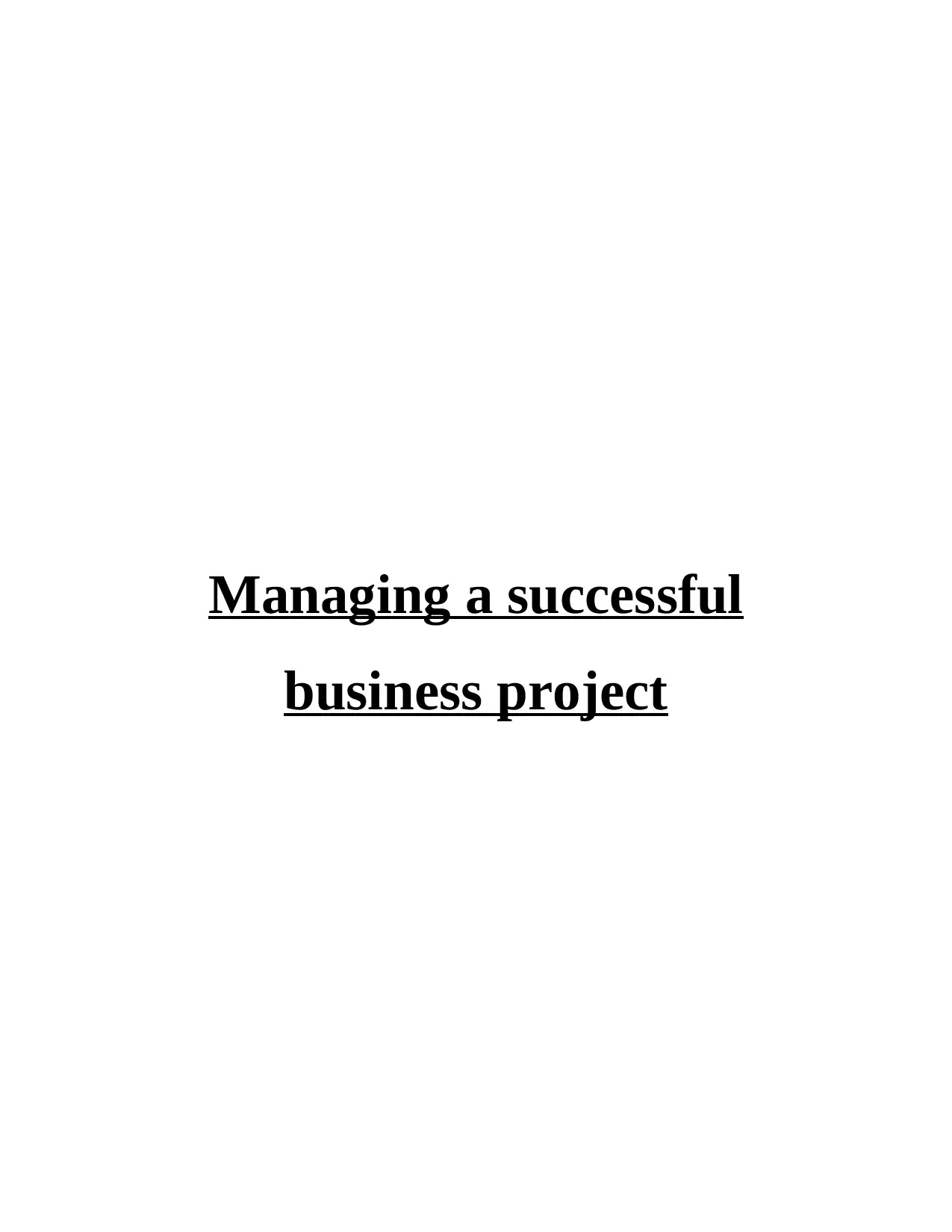
Managing a successful
business project
business project
Paraphrase This Document
Need a fresh take? Get an instant paraphrase of this document with our AI Paraphraser
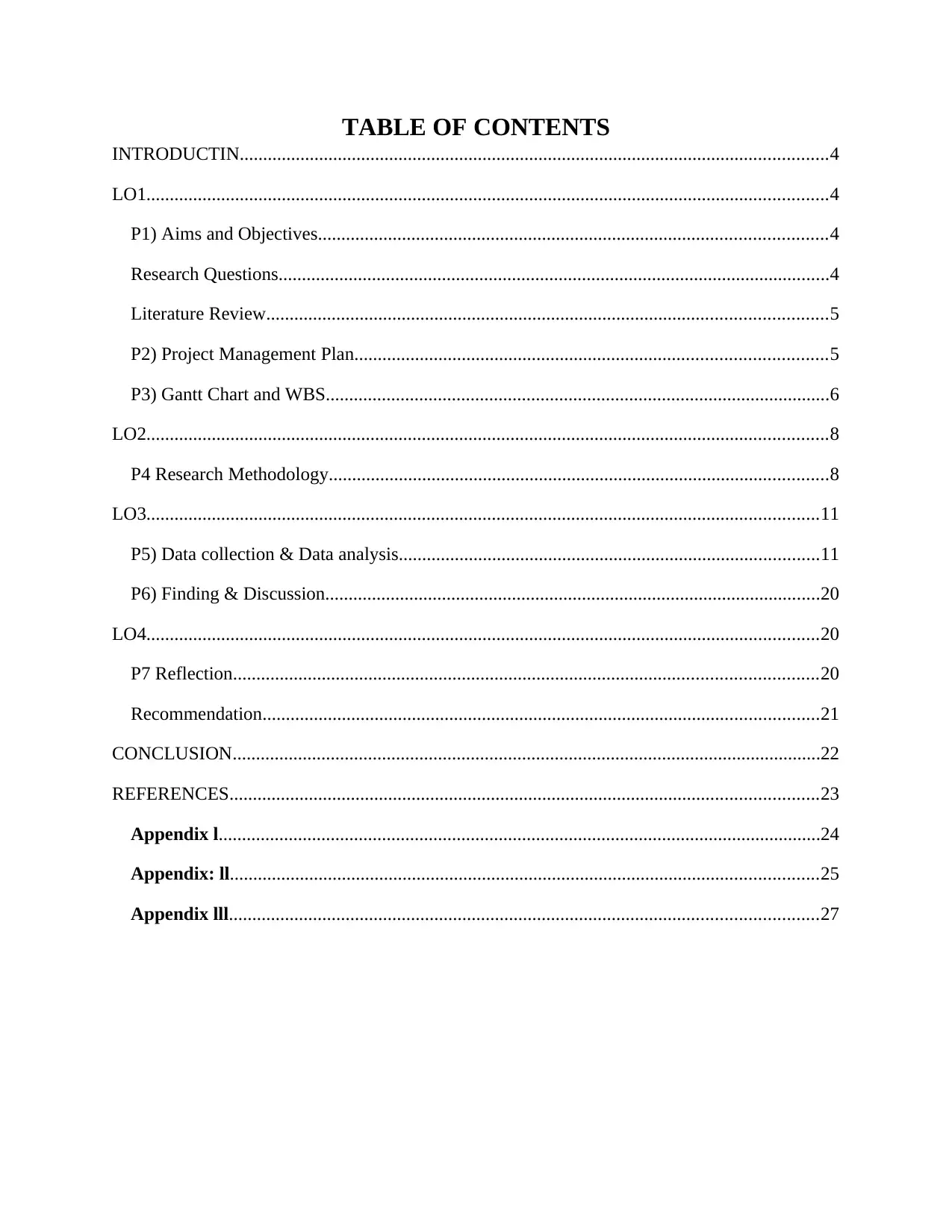
TABLE OF CONTENTS
INTRODUCTIN..............................................................................................................................4
LO1..................................................................................................................................................4
P1) Aims and Objectives.............................................................................................................4
Research Questions......................................................................................................................4
Literature Review........................................................................................................................5
P2) Project Management Plan.....................................................................................................5
P3) Gantt Chart and WBS............................................................................................................6
LO2..................................................................................................................................................8
P4 Research Methodology...........................................................................................................8
LO3................................................................................................................................................11
P5) Data collection & Data analysis..........................................................................................11
P6) Finding & Discussion..........................................................................................................20
LO4................................................................................................................................................20
P7 Reflection.............................................................................................................................20
Recommendation.......................................................................................................................21
CONCLUSION..............................................................................................................................22
REFERENCES..............................................................................................................................23
Appendix l.................................................................................................................................24
Appendix: ll..............................................................................................................................25
Appendix lll..............................................................................................................................27
INTRODUCTIN..............................................................................................................................4
LO1..................................................................................................................................................4
P1) Aims and Objectives.............................................................................................................4
Research Questions......................................................................................................................4
Literature Review........................................................................................................................5
P2) Project Management Plan.....................................................................................................5
P3) Gantt Chart and WBS............................................................................................................6
LO2..................................................................................................................................................8
P4 Research Methodology...........................................................................................................8
LO3................................................................................................................................................11
P5) Data collection & Data analysis..........................................................................................11
P6) Finding & Discussion..........................................................................................................20
LO4................................................................................................................................................20
P7 Reflection.............................................................................................................................20
Recommendation.......................................................................................................................21
CONCLUSION..............................................................................................................................22
REFERENCES..............................................................................................................................23
Appendix l.................................................................................................................................24
Appendix: ll..............................................................................................................................25
Appendix lll..............................................................................................................................27
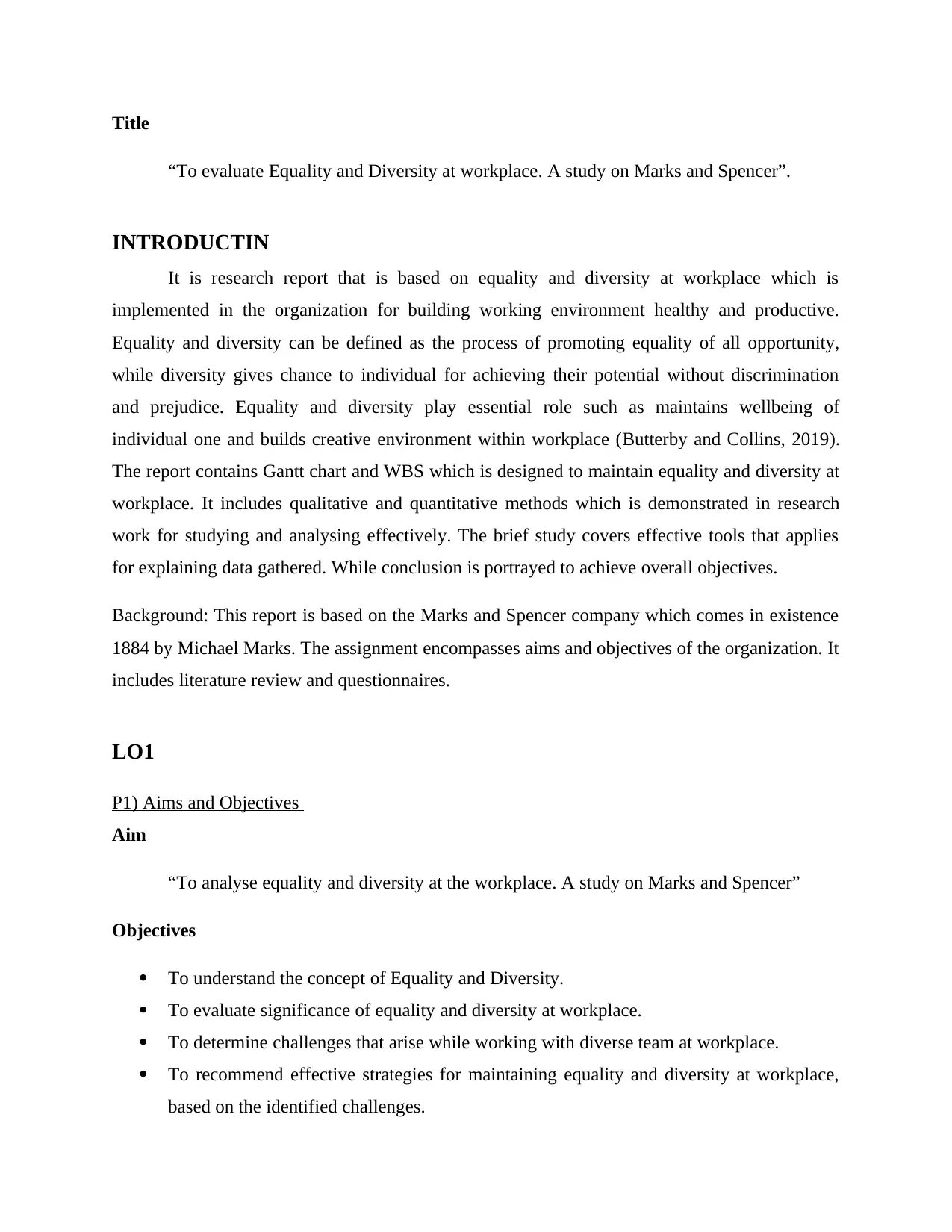
Title
“To evaluate Equality and Diversity at workplace. A study on Marks and Spencer”.
INTRODUCTIN
It is research report that is based on equality and diversity at workplace which is
implemented in the organization for building working environment healthy and productive.
Equality and diversity can be defined as the process of promoting equality of all opportunity,
while diversity gives chance to individual for achieving their potential without discrimination
and prejudice. Equality and diversity play essential role such as maintains wellbeing of
individual one and builds creative environment within workplace (Butterby and Collins, 2019).
The report contains Gantt chart and WBS which is designed to maintain equality and diversity at
workplace. It includes qualitative and quantitative methods which is demonstrated in research
work for studying and analysing effectively. The brief study covers effective tools that applies
for explaining data gathered. While conclusion is portrayed to achieve overall objectives.
Background: This report is based on the Marks and Spencer company which comes in existence
1884 by Michael Marks. The assignment encompasses aims and objectives of the organization. It
includes literature review and questionnaires.
LO1
P1) Aims and Objectives
Aim
“To analyse equality and diversity at the workplace. A study on Marks and Spencer”
Objectives
To understand the concept of Equality and Diversity.
To evaluate significance of equality and diversity at workplace.
To determine challenges that arise while working with diverse team at workplace.
To recommend effective strategies for maintaining equality and diversity at workplace,
based on the identified challenges.
“To evaluate Equality and Diversity at workplace. A study on Marks and Spencer”.
INTRODUCTIN
It is research report that is based on equality and diversity at workplace which is
implemented in the organization for building working environment healthy and productive.
Equality and diversity can be defined as the process of promoting equality of all opportunity,
while diversity gives chance to individual for achieving their potential without discrimination
and prejudice. Equality and diversity play essential role such as maintains wellbeing of
individual one and builds creative environment within workplace (Butterby and Collins, 2019).
The report contains Gantt chart and WBS which is designed to maintain equality and diversity at
workplace. It includes qualitative and quantitative methods which is demonstrated in research
work for studying and analysing effectively. The brief study covers effective tools that applies
for explaining data gathered. While conclusion is portrayed to achieve overall objectives.
Background: This report is based on the Marks and Spencer company which comes in existence
1884 by Michael Marks. The assignment encompasses aims and objectives of the organization. It
includes literature review and questionnaires.
LO1
P1) Aims and Objectives
Aim
“To analyse equality and diversity at the workplace. A study on Marks and Spencer”
Objectives
To understand the concept of Equality and Diversity.
To evaluate significance of equality and diversity at workplace.
To determine challenges that arise while working with diverse team at workplace.
To recommend effective strategies for maintaining equality and diversity at workplace,
based on the identified challenges.
⊘ This is a preview!⊘
Do you want full access?
Subscribe today to unlock all pages.

Trusted by 1+ million students worldwide
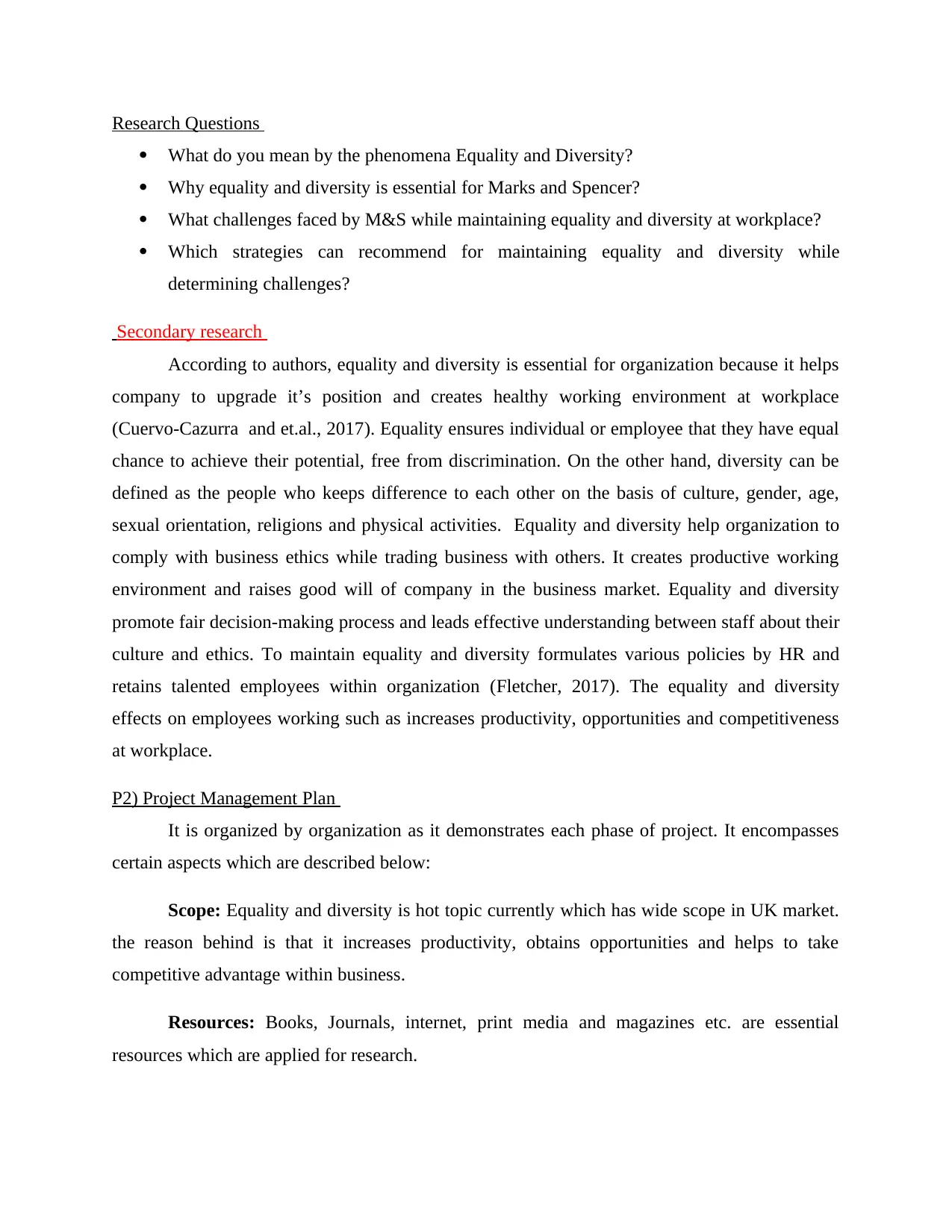
Research Questions
What do you mean by the phenomena Equality and Diversity?
Why equality and diversity is essential for Marks and Spencer?
What challenges faced by M&S while maintaining equality and diversity at workplace?
Which strategies can recommend for maintaining equality and diversity while
determining challenges?
Secondary research
According to authors, equality and diversity is essential for organization because it helps
company to upgrade it’s position and creates healthy working environment at workplace
(Cuervo‐Cazurra and et.al., 2017). Equality ensures individual or employee that they have equal
chance to achieve their potential, free from discrimination. On the other hand, diversity can be
defined as the people who keeps difference to each other on the basis of culture, gender, age,
sexual orientation, religions and physical activities. Equality and diversity help organization to
comply with business ethics while trading business with others. It creates productive working
environment and raises good will of company in the business market. Equality and diversity
promote fair decision-making process and leads effective understanding between staff about their
culture and ethics. To maintain equality and diversity formulates various policies by HR and
retains talented employees within organization (Fletcher, 2017). The equality and diversity
effects on employees working such as increases productivity, opportunities and competitiveness
at workplace.
P2) Project Management Plan
It is organized by organization as it demonstrates each phase of project. It encompasses
certain aspects which are described below:
Scope: Equality and diversity is hot topic currently which has wide scope in UK market.
the reason behind is that it increases productivity, obtains opportunities and helps to take
competitive advantage within business.
Resources: Books, Journals, internet, print media and magazines etc. are essential
resources which are applied for research.
What do you mean by the phenomena Equality and Diversity?
Why equality and diversity is essential for Marks and Spencer?
What challenges faced by M&S while maintaining equality and diversity at workplace?
Which strategies can recommend for maintaining equality and diversity while
determining challenges?
Secondary research
According to authors, equality and diversity is essential for organization because it helps
company to upgrade it’s position and creates healthy working environment at workplace
(Cuervo‐Cazurra and et.al., 2017). Equality ensures individual or employee that they have equal
chance to achieve their potential, free from discrimination. On the other hand, diversity can be
defined as the people who keeps difference to each other on the basis of culture, gender, age,
sexual orientation, religions and physical activities. Equality and diversity help organization to
comply with business ethics while trading business with others. It creates productive working
environment and raises good will of company in the business market. Equality and diversity
promote fair decision-making process and leads effective understanding between staff about their
culture and ethics. To maintain equality and diversity formulates various policies by HR and
retains talented employees within organization (Fletcher, 2017). The equality and diversity
effects on employees working such as increases productivity, opportunities and competitiveness
at workplace.
P2) Project Management Plan
It is organized by organization as it demonstrates each phase of project. It encompasses
certain aspects which are described below:
Scope: Equality and diversity is hot topic currently which has wide scope in UK market.
the reason behind is that it increases productivity, obtains opportunities and helps to take
competitive advantage within business.
Resources: Books, Journals, internet, print media and magazines etc. are essential
resources which are applied for research.
Paraphrase This Document
Need a fresh take? Get an instant paraphrase of this document with our AI Paraphraser
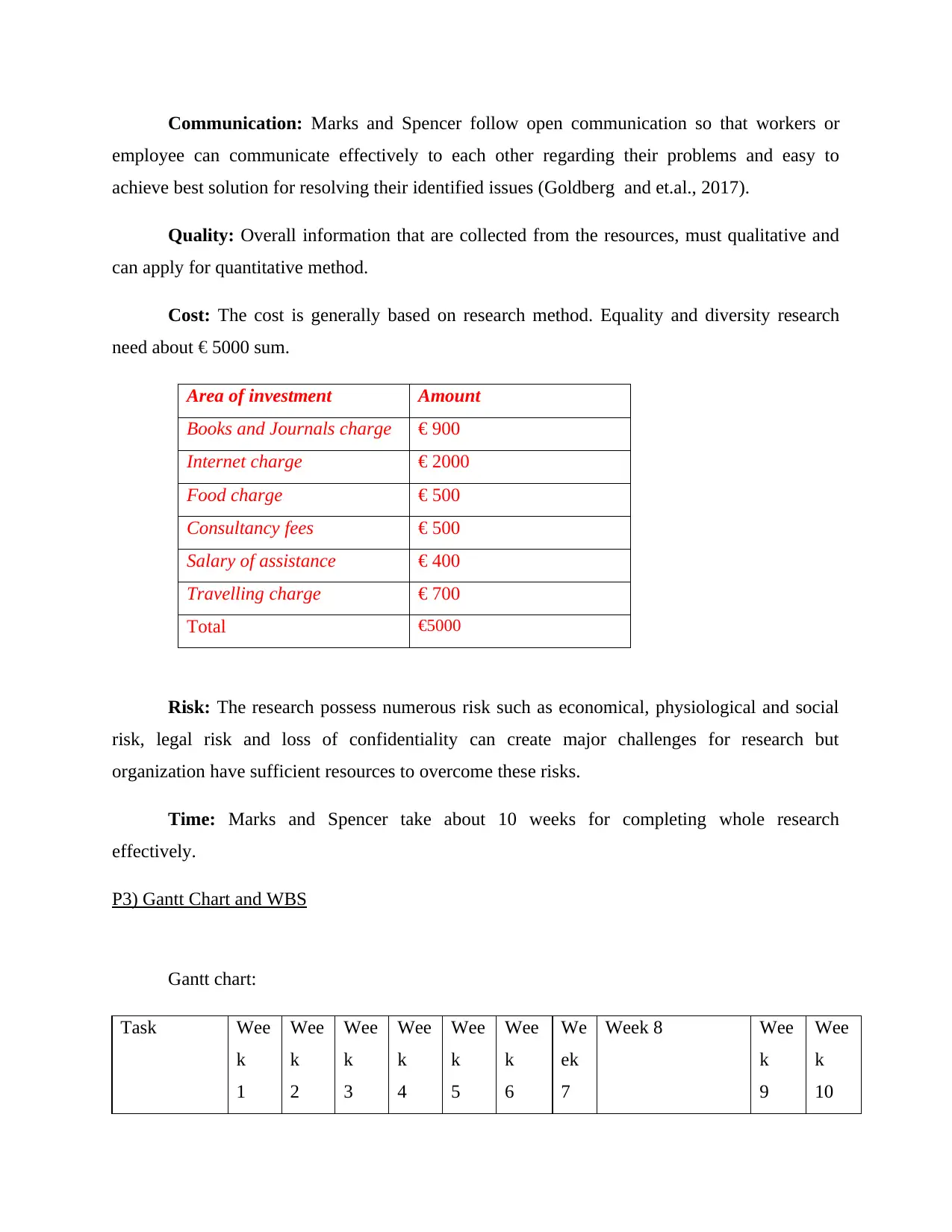
Communication: Marks and Spencer follow open communication so that workers or
employee can communicate effectively to each other regarding their problems and easy to
achieve best solution for resolving their identified issues (Goldberg and et.al., 2017).
Quality: Overall information that are collected from the resources, must qualitative and
can apply for quantitative method.
Cost: The cost is generally based on research method. Equality and diversity research
need about € 5000 sum.
Area of investment Amount
Books and Journals charge € 900
Internet charge € 2000
Food charge € 500
Consultancy fees € 500
Salary of assistance € 400
Travelling charge € 700
Total €5000
Risk: The research possess numerous risk such as economical, physiological and social
risk, legal risk and loss of confidentiality can create major challenges for research but
organization have sufficient resources to overcome these risks.
Time: Marks and Spencer take about 10 weeks for completing whole research
effectively.
P3) Gantt Chart and WBS
Gantt chart:
Task Wee
k
1
Wee
k
2
Wee
k
3
Wee
k
4
Wee
k
5
Wee
k
6
We
ek
7
Week 8 Wee
k
9
Wee
k
10
employee can communicate effectively to each other regarding their problems and easy to
achieve best solution for resolving their identified issues (Goldberg and et.al., 2017).
Quality: Overall information that are collected from the resources, must qualitative and
can apply for quantitative method.
Cost: The cost is generally based on research method. Equality and diversity research
need about € 5000 sum.
Area of investment Amount
Books and Journals charge € 900
Internet charge € 2000
Food charge € 500
Consultancy fees € 500
Salary of assistance € 400
Travelling charge € 700
Total €5000
Risk: The research possess numerous risk such as economical, physiological and social
risk, legal risk and loss of confidentiality can create major challenges for research but
organization have sufficient resources to overcome these risks.
Time: Marks and Spencer take about 10 weeks for completing whole research
effectively.
P3) Gantt Chart and WBS
Gantt chart:
Task Wee
k
1
Wee
k
2
Wee
k
3
Wee
k
4
Wee
k
5
Wee
k
6
We
ek
7
Week 8 Wee
k
9
Wee
k
10
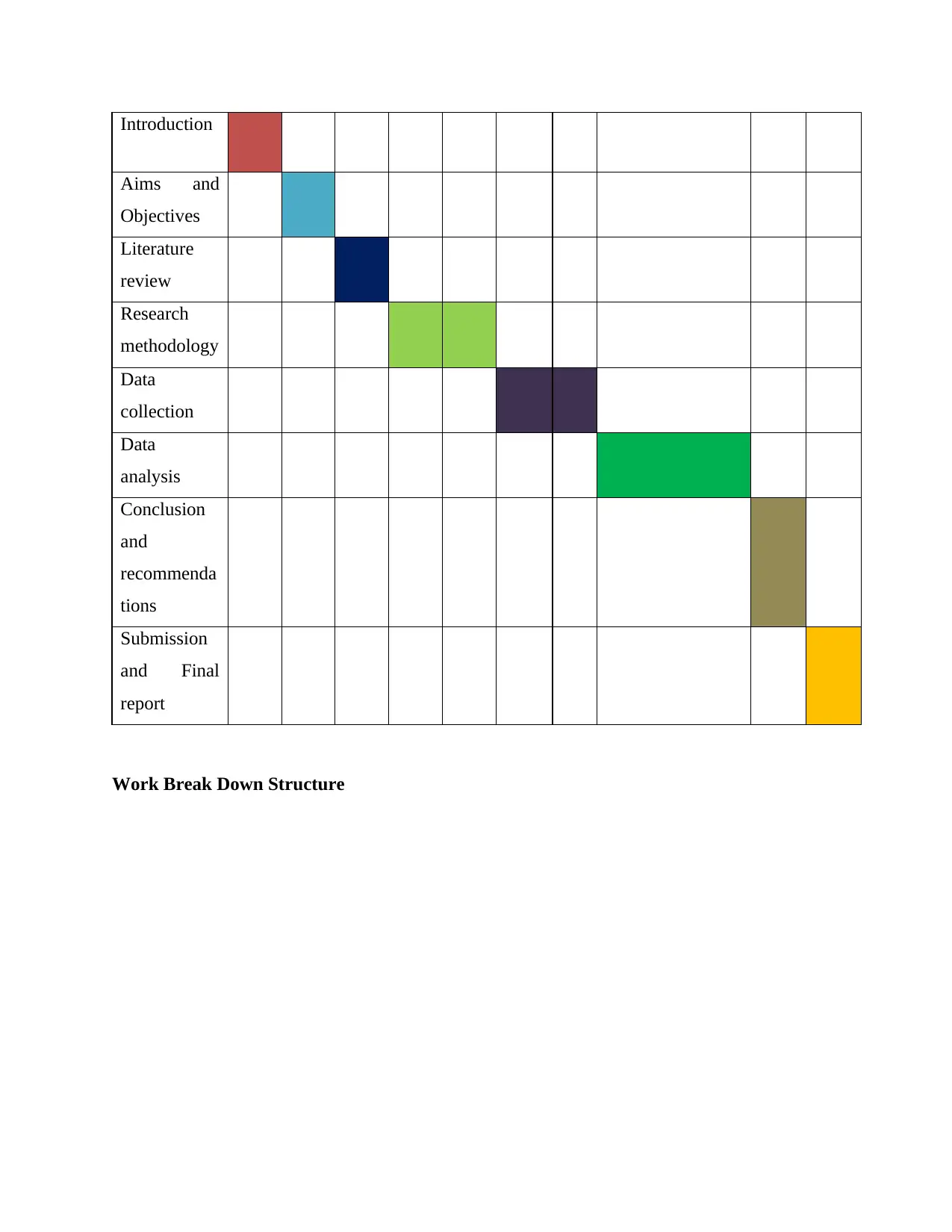
Introduction
Aims and
Objectives
Literature
review
Research
methodology
Data
collection
Data
analysis
Conclusion
and
recommenda
tions
Submission
and Final
report
Work Break Down Structure
Aims and
Objectives
Literature
review
Research
methodology
Data
collection
Data
analysis
Conclusion
and
recommenda
tions
Submission
and Final
report
Work Break Down Structure
⊘ This is a preview!⊘
Do you want full access?
Subscribe today to unlock all pages.

Trusted by 1+ million students worldwide
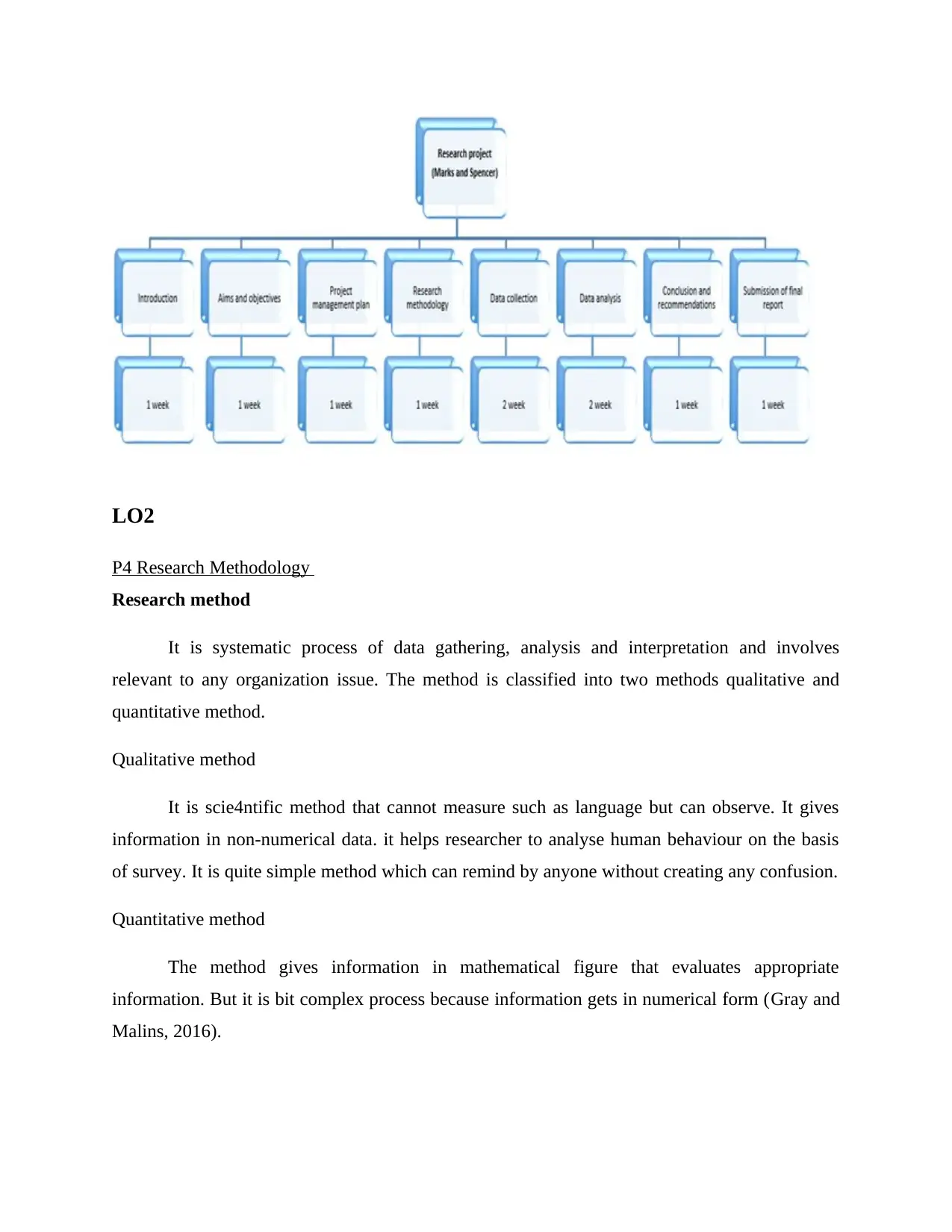
LO2
P4 Research Methodology
Research method
It is systematic process of data gathering, analysis and interpretation and involves
relevant to any organization issue. The method is classified into two methods qualitative and
quantitative method.
Qualitative method
It is scie4ntific method that cannot measure such as language but can observe. It gives
information in non-numerical data. it helps researcher to analyse human behaviour on the basis
of survey. It is quite simple method which can remind by anyone without creating any confusion.
Quantitative method
The method gives information in mathematical figure that evaluates appropriate
information. But it is bit complex process because information gets in numerical form (Gray and
Malins, 2016).
P4 Research Methodology
Research method
It is systematic process of data gathering, analysis and interpretation and involves
relevant to any organization issue. The method is classified into two methods qualitative and
quantitative method.
Qualitative method
It is scie4ntific method that cannot measure such as language but can observe. It gives
information in non-numerical data. it helps researcher to analyse human behaviour on the basis
of survey. It is quite simple method which can remind by anyone without creating any confusion.
Quantitative method
The method gives information in mathematical figure that evaluates appropriate
information. But it is bit complex process because information gets in numerical form (Gray and
Malins, 2016).
Paraphrase This Document
Need a fresh take? Get an instant paraphrase of this document with our AI Paraphraser
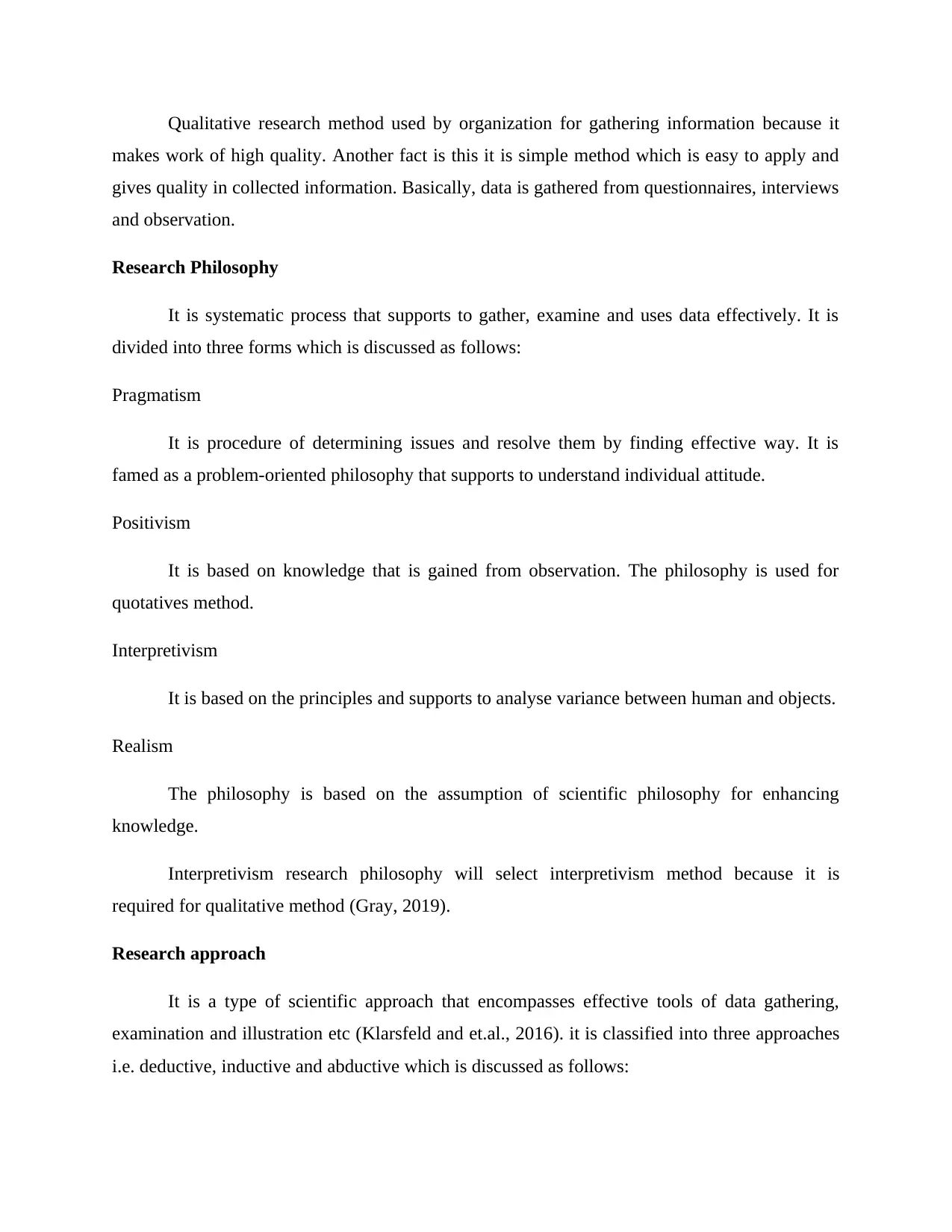
Qualitative research method used by organization for gathering information because it
makes work of high quality. Another fact is this it is simple method which is easy to apply and
gives quality in collected information. Basically, data is gathered from questionnaires, interviews
and observation.
Research Philosophy
It is systematic process that supports to gather, examine and uses data effectively. It is
divided into three forms which is discussed as follows:
Pragmatism
It is procedure of determining issues and resolve them by finding effective way. It is
famed as a problem-oriented philosophy that supports to understand individual attitude.
Positivism
It is based on knowledge that is gained from observation. The philosophy is used for
quotatives method.
Interpretivism
It is based on the principles and supports to analyse variance between human and objects.
Realism
The philosophy is based on the assumption of scientific philosophy for enhancing
knowledge.
Interpretivism research philosophy will select interpretivism method because it is
required for qualitative method (Gray, 2019).
Research approach
It is a type of scientific approach that encompasses effective tools of data gathering,
examination and illustration etc (Klarsfeld and et.al., 2016). it is classified into three approaches
i.e. deductive, inductive and abductive which is discussed as follows:
makes work of high quality. Another fact is this it is simple method which is easy to apply and
gives quality in collected information. Basically, data is gathered from questionnaires, interviews
and observation.
Research Philosophy
It is systematic process that supports to gather, examine and uses data effectively. It is
divided into three forms which is discussed as follows:
Pragmatism
It is procedure of determining issues and resolve them by finding effective way. It is
famed as a problem-oriented philosophy that supports to understand individual attitude.
Positivism
It is based on knowledge that is gained from observation. The philosophy is used for
quotatives method.
Interpretivism
It is based on the principles and supports to analyse variance between human and objects.
Realism
The philosophy is based on the assumption of scientific philosophy for enhancing
knowledge.
Interpretivism research philosophy will select interpretivism method because it is
required for qualitative method (Gray, 2019).
Research approach
It is a type of scientific approach that encompasses effective tools of data gathering,
examination and illustration etc (Klarsfeld and et.al., 2016). it is classified into three approaches
i.e. deductive, inductive and abductive which is discussed as follows:
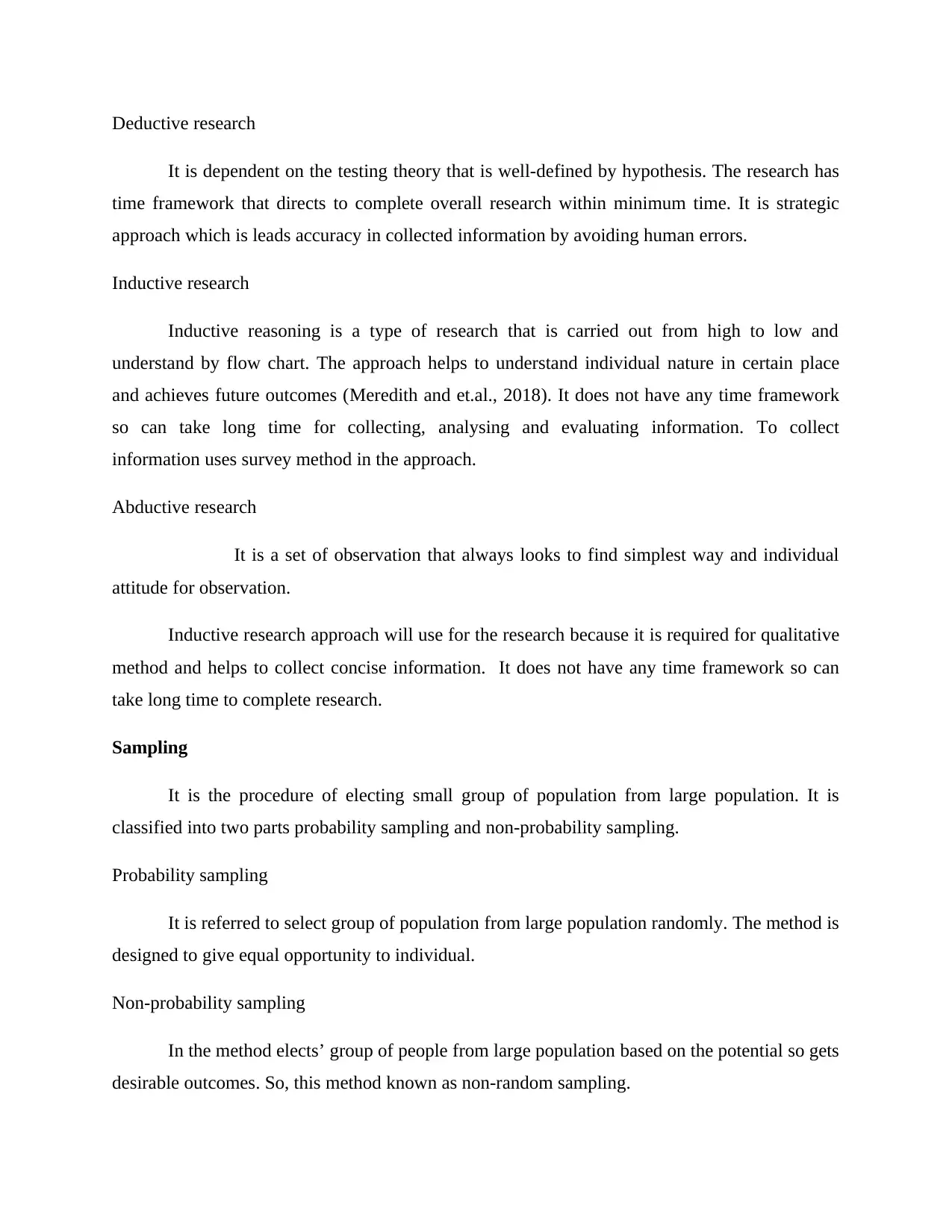
Deductive research
It is dependent on the testing theory that is well-defined by hypothesis. The research has
time framework that directs to complete overall research within minimum time. It is strategic
approach which is leads accuracy in collected information by avoiding human errors.
Inductive research
Inductive reasoning is a type of research that is carried out from high to low and
understand by flow chart. The approach helps to understand individual nature in certain place
and achieves future outcomes (Meredith and et.al., 2018). It does not have any time framework
so can take long time for collecting, analysing and evaluating information. To collect
information uses survey method in the approach.
Abductive research
It is a set of observation that always looks to find simplest way and individual
attitude for observation.
Inductive research approach will use for the research because it is required for qualitative
method and helps to collect concise information. It does not have any time framework so can
take long time to complete research.
Sampling
It is the procedure of electing small group of population from large population. It is
classified into two parts probability sampling and non-probability sampling.
Probability sampling
It is referred to select group of population from large population randomly. The method is
designed to give equal opportunity to individual.
Non-probability sampling
In the method elects’ group of people from large population based on the potential so gets
desirable outcomes. So, this method known as non-random sampling.
It is dependent on the testing theory that is well-defined by hypothesis. The research has
time framework that directs to complete overall research within minimum time. It is strategic
approach which is leads accuracy in collected information by avoiding human errors.
Inductive research
Inductive reasoning is a type of research that is carried out from high to low and
understand by flow chart. The approach helps to understand individual nature in certain place
and achieves future outcomes (Meredith and et.al., 2018). It does not have any time framework
so can take long time for collecting, analysing and evaluating information. To collect
information uses survey method in the approach.
Abductive research
It is a set of observation that always looks to find simplest way and individual
attitude for observation.
Inductive research approach will use for the research because it is required for qualitative
method and helps to collect concise information. It does not have any time framework so can
take long time to complete research.
Sampling
It is the procedure of electing small group of population from large population. It is
classified into two parts probability sampling and non-probability sampling.
Probability sampling
It is referred to select group of population from large population randomly. The method is
designed to give equal opportunity to individual.
Non-probability sampling
In the method elects’ group of people from large population based on the potential so gets
desirable outcomes. So, this method known as non-random sampling.
⊘ This is a preview!⊘
Do you want full access?
Subscribe today to unlock all pages.

Trusted by 1+ million students worldwide
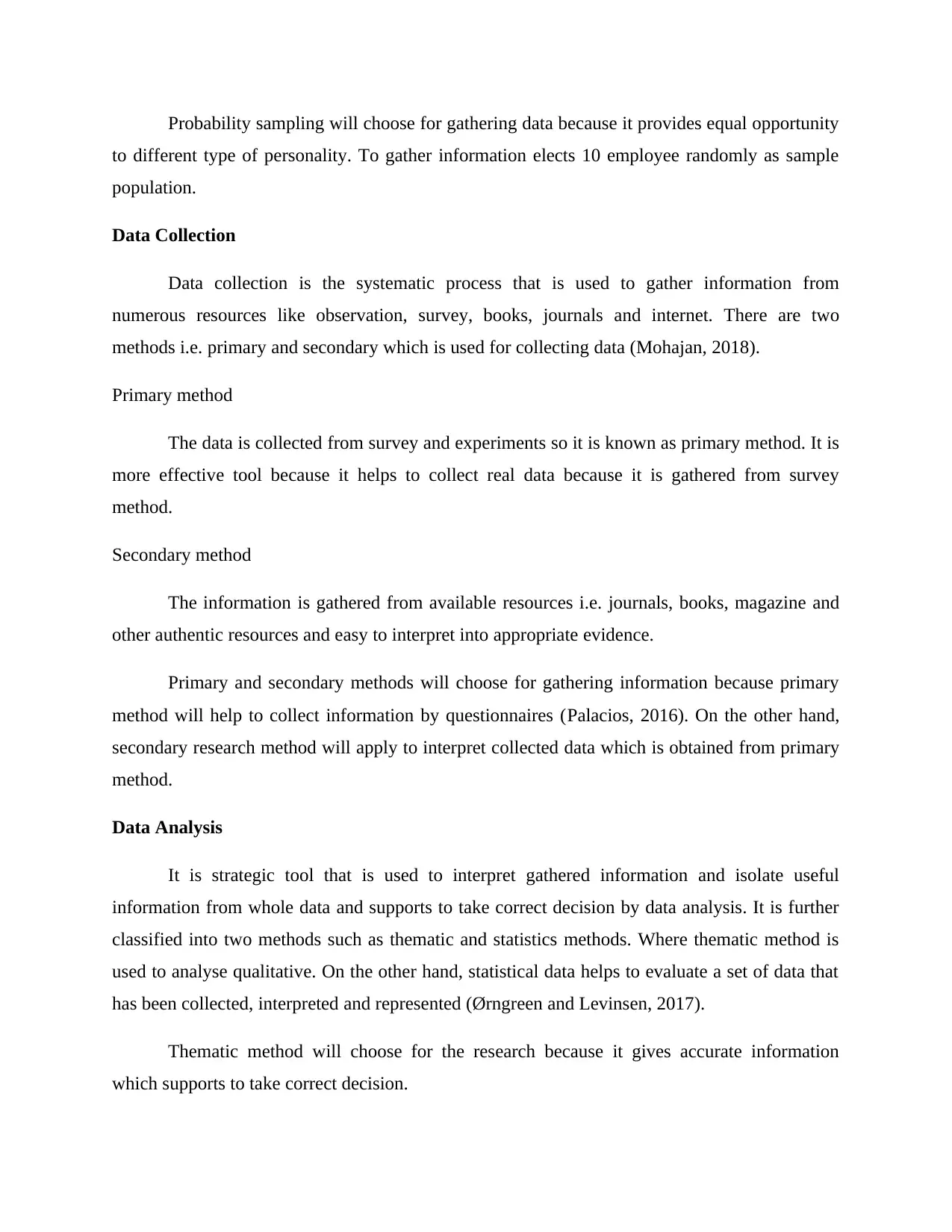
Probability sampling will choose for gathering data because it provides equal opportunity
to different type of personality. To gather information elects 10 employee randomly as sample
population.
Data Collection
Data collection is the systematic process that is used to gather information from
numerous resources like observation, survey, books, journals and internet. There are two
methods i.e. primary and secondary which is used for collecting data (Mohajan, 2018).
Primary method
The data is collected from survey and experiments so it is known as primary method. It is
more effective tool because it helps to collect real data because it is gathered from survey
method.
Secondary method
The information is gathered from available resources i.e. journals, books, magazine and
other authentic resources and easy to interpret into appropriate evidence.
Primary and secondary methods will choose for gathering information because primary
method will help to collect information by questionnaires (Palacios, 2016). On the other hand,
secondary research method will apply to interpret collected data which is obtained from primary
method.
Data Analysis
It is strategic tool that is used to interpret gathered information and isolate useful
information from whole data and supports to take correct decision by data analysis. It is further
classified into two methods such as thematic and statistics methods. Where thematic method is
used to analyse qualitative. On the other hand, statistical data helps to evaluate a set of data that
has been collected, interpreted and represented (Ørngreen and Levinsen, 2017).
Thematic method will choose for the research because it gives accurate information
which supports to take correct decision.
to different type of personality. To gather information elects 10 employee randomly as sample
population.
Data Collection
Data collection is the systematic process that is used to gather information from
numerous resources like observation, survey, books, journals and internet. There are two
methods i.e. primary and secondary which is used for collecting data (Mohajan, 2018).
Primary method
The data is collected from survey and experiments so it is known as primary method. It is
more effective tool because it helps to collect real data because it is gathered from survey
method.
Secondary method
The information is gathered from available resources i.e. journals, books, magazine and
other authentic resources and easy to interpret into appropriate evidence.
Primary and secondary methods will choose for gathering information because primary
method will help to collect information by questionnaires (Palacios, 2016). On the other hand,
secondary research method will apply to interpret collected data which is obtained from primary
method.
Data Analysis
It is strategic tool that is used to interpret gathered information and isolate useful
information from whole data and supports to take correct decision by data analysis. It is further
classified into two methods such as thematic and statistics methods. Where thematic method is
used to analyse qualitative. On the other hand, statistical data helps to evaluate a set of data that
has been collected, interpreted and represented (Ørngreen and Levinsen, 2017).
Thematic method will choose for the research because it gives accurate information
which supports to take correct decision.
Paraphrase This Document
Need a fresh take? Get an instant paraphrase of this document with our AI Paraphraser
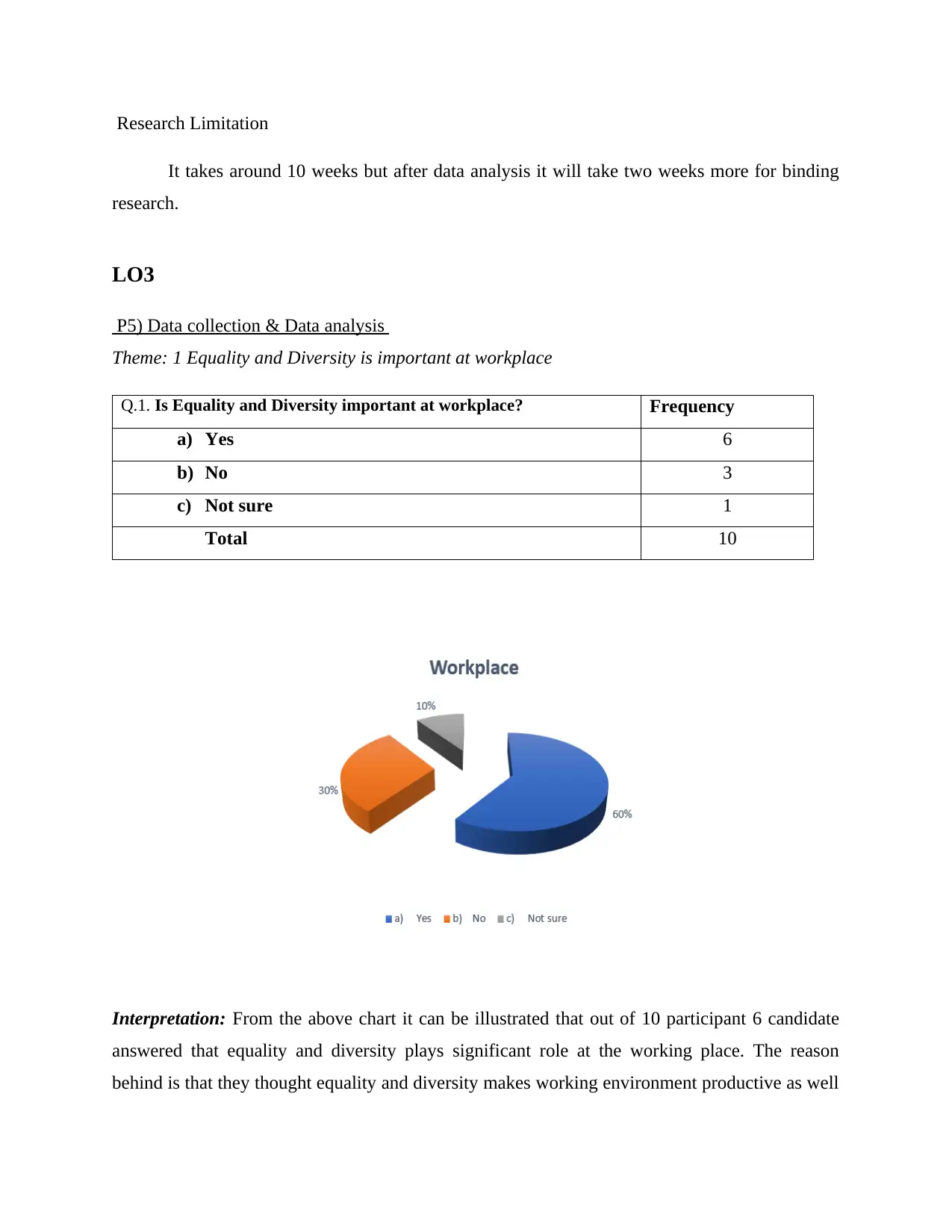
Research Limitation
It takes around 10 weeks but after data analysis it will take two weeks more for binding
research.
LO3
P5) Data collection & Data analysis
Theme: 1 Equality and Diversity is important at workplace
Q.1. Is Equality and Diversity important at workplace? Frequency
a) Yes 6
b) No 3
c) Not sure 1
Total 10
Interpretation: From the above chart it can be illustrated that out of 10 participant 6 candidate
answered that equality and diversity plays significant role at the working place. The reason
behind is that they thought equality and diversity makes working environment productive as well
It takes around 10 weeks but after data analysis it will take two weeks more for binding
research.
LO3
P5) Data collection & Data analysis
Theme: 1 Equality and Diversity is important at workplace
Q.1. Is Equality and Diversity important at workplace? Frequency
a) Yes 6
b) No 3
c) Not sure 1
Total 10
Interpretation: From the above chart it can be illustrated that out of 10 participant 6 candidate
answered that equality and diversity plays significant role at the working place. The reason
behind is that they thought equality and diversity makes working environment productive as well
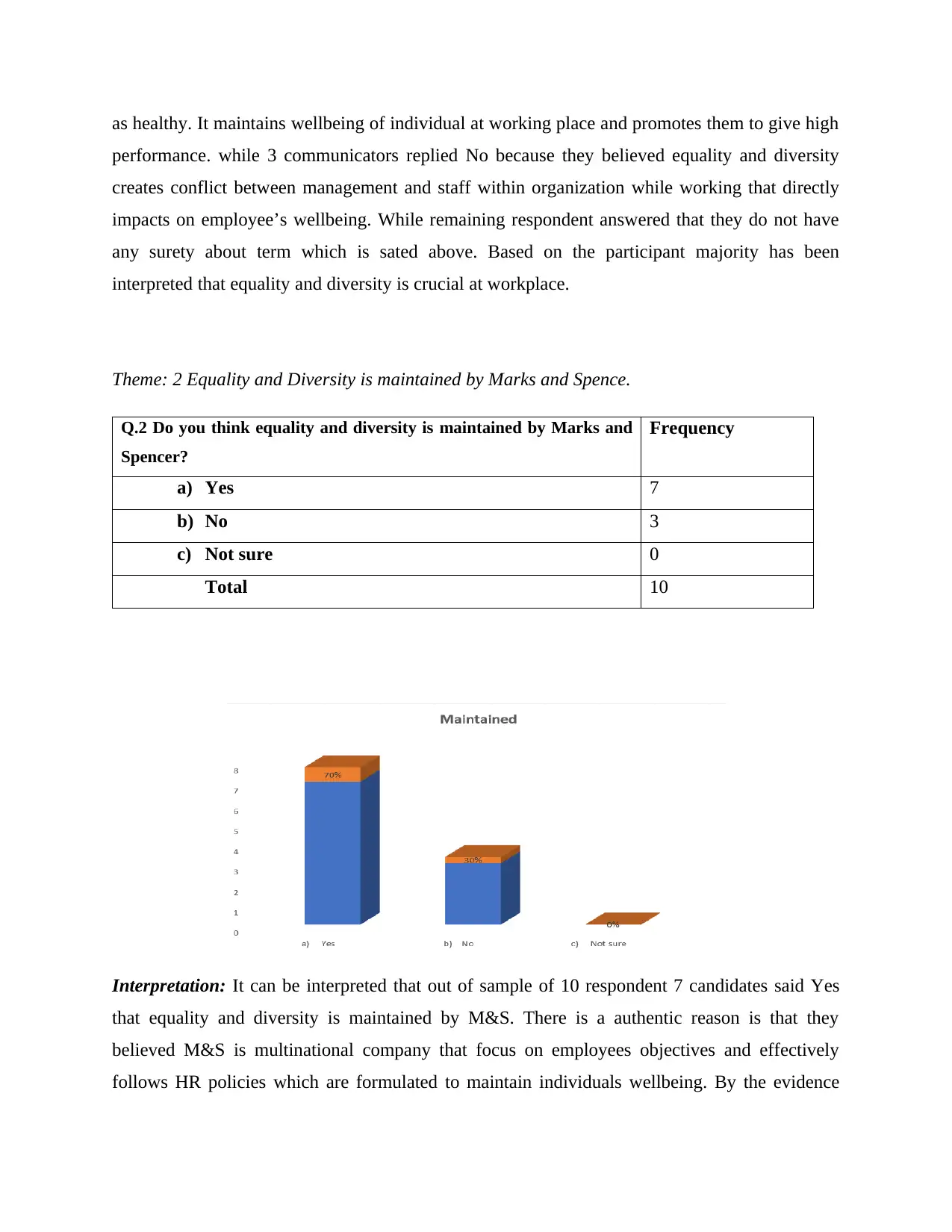
as healthy. It maintains wellbeing of individual at working place and promotes them to give high
performance. while 3 communicators replied No because they believed equality and diversity
creates conflict between management and staff within organization while working that directly
impacts on employee’s wellbeing. While remaining respondent answered that they do not have
any surety about term which is sated above. Based on the participant majority has been
interpreted that equality and diversity is crucial at workplace.
Theme: 2 Equality and Diversity is maintained by Marks and Spence.
Q.2 Do you think equality and diversity is maintained by Marks and
Spencer?
Frequency
a) Yes 7
b) No 3
c) Not sure 0
Total 10
Interpretation: It can be interpreted that out of sample of 10 respondent 7 candidates said Yes
that equality and diversity is maintained by M&S. There is a authentic reason is that they
believed M&S is multinational company that focus on employees objectives and effectively
follows HR policies which are formulated to maintain individuals wellbeing. By the evidence
performance. while 3 communicators replied No because they believed equality and diversity
creates conflict between management and staff within organization while working that directly
impacts on employee’s wellbeing. While remaining respondent answered that they do not have
any surety about term which is sated above. Based on the participant majority has been
interpreted that equality and diversity is crucial at workplace.
Theme: 2 Equality and Diversity is maintained by Marks and Spence.
Q.2 Do you think equality and diversity is maintained by Marks and
Spencer?
Frequency
a) Yes 7
b) No 3
c) Not sure 0
Total 10
Interpretation: It can be interpreted that out of sample of 10 respondent 7 candidates said Yes
that equality and diversity is maintained by M&S. There is a authentic reason is that they
believed M&S is multinational company that focus on employees objectives and effectively
follows HR policies which are formulated to maintain individuals wellbeing. By the evidence
⊘ This is a preview!⊘
Do you want full access?
Subscribe today to unlock all pages.

Trusted by 1+ million students worldwide
1 out of 29
Related Documents
Your All-in-One AI-Powered Toolkit for Academic Success.
+13062052269
info@desklib.com
Available 24*7 on WhatsApp / Email
![[object Object]](/_next/static/media/star-bottom.7253800d.svg)
Unlock your academic potential
Copyright © 2020–2025 A2Z Services. All Rights Reserved. Developed and managed by ZUCOL.





